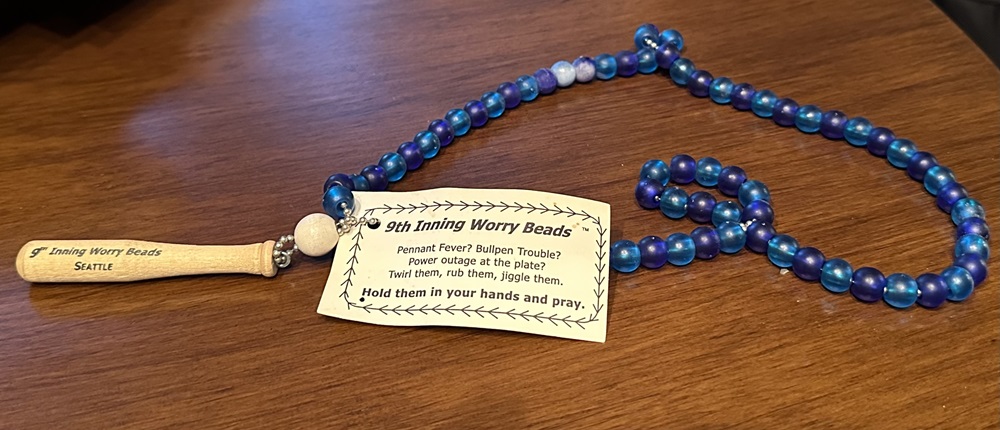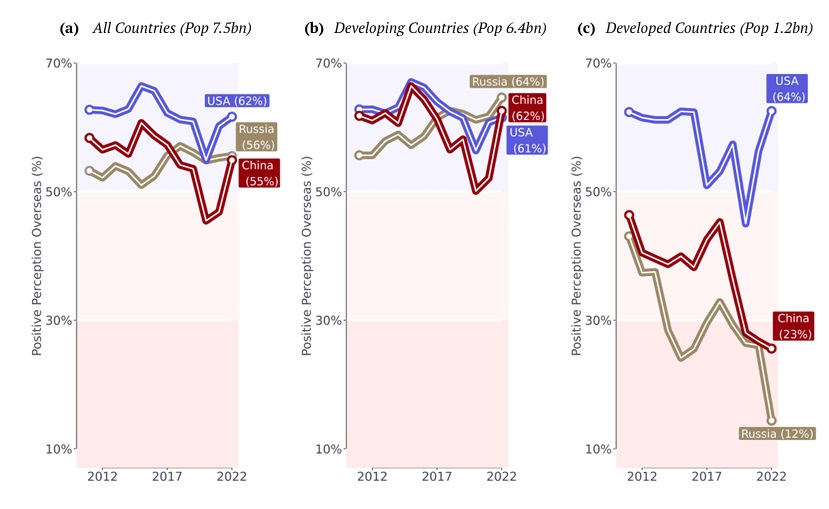We are told that people worry a lot nowadays. Anxiety is high, including and especially in young people who are worried about, well, nearly everything. Years ago in the mid 1990s we started a small business exploiting worry, specifically our concerns about the Seattle Mariners. You see, back then they had a good team but a horrible bullpen and would lose many games in the late innings. We had recently been in Greece, where we saw old men sitting on chairs, standing on street corners fiddling—worrying—short strings of beads in their hands. We learned these were called worry beads.
Our “Aha” moment was to create worry beads for Seattle Mariners fans. And so with a friend we founded Beadle Enterprises and created a prototype that we ended up calling 9th Inning Worry Beads. They came in both necklace size and traditional. The beads were in the blue and teal colors of the Mariners along with one white baseball bead attached to a small wooden bat. We learned a lot in this business. One day we met our business partner in a restaurant and we twirled the beads while holding the small bat. The chain was attached to the bat through a small eyelet. But twirling the bat, unnoticed by us, caused the eyelet to unscrew from the bat and the beads went flying all across the restaurant. This, needless to say, was a liability problem—we pictured hundreds of fans twirling their beads in the old Kingdome, beads flying everywhere and multiple people losing an eye. We added glue to the prototype. Mariners fans, the most persecuted fans in any sport, continue to need worry beads.
But now we realize we did not think big enough. We should create worry beads themed to all sorts of worries. Election worry beads (in America red and blue beads, of course), climate change worry beads (shades of green), inflation worry beads (large beads) and whatever else gives folks fear. And today we worry you don’t know about how beer and tea drove the industrial revolution in Britain, that the world is realigning, and that China and Russia are in cahoots. It’s this week’s International Need to Know, the Greek philosopher of international information, the Spartan warrior of global data.
Without further ado, here’s what you need to know.
Beer and Tea Saved the Industrial Revolution?
The Industrial Revolution changed the fate of humans for the better though even today most people don’t know it (rather than the 10 Commandments it would be better to post “The Industrial Revolution Made Your Life Better” in all schools, not just in the U.S. but around the world). For thousands of years life did not improve tremendously for humans. But with the advent of the Industrial Revolution we’ve seen continuous improvements in quality and length of life. Perhaps it’s appropriate we learned about tea and beer’s role in the Industrial Revolution from one of our sources of information for the current AI advances, a technology which might lead to a new revolution. Ethan Mollick points out that “‘beer and tea powered the Industrial Revolution by sustaining the British population boom.” Beer and tea? Wonderful as those two beverages are, you might ask how they sustained the population boom. According to a 2022 study, “beer scarcity was associated with higher mortality, especially in the summer months where mortality was more likely to be driven by water-borne illnesses.” And tea? Well, you boil the water to make it, eliminating the dangerous microorganisms in the water. This helped to bring good health which helped sustain the Industrial Revolution. So when you have your afternoon tea and evening beer, or vice versa, give it the respect it deserves.
The Continued Realignment
The world continues to realign, but how and in what form is complicated. We saw a tweet by David Shor asserting that world opinion around Russia and China is correlated by how socially liberal a country is. He derived his assertion based on a new study at the University of Cambridge: A World Divided, Russia, China and the West. The claim is that more socially liberal countries are more likely to have unfavorable opinions of China and Russia. But when we read the study it was more complicated than that. First, the study looks at the views of populations of developed countries, developing countries, democracies and non-democracies. Second, their views of China and Russia vary. These countries don’t view the countries the same, some favor China and some Russia. Third, the study asserts there is an increase in affinity for Russia in South and Southeast Asia. But that’s driven by the large populations of India and Indonesia, both of which are more favorably inclined to Russia than other countries in the region. Vietnamese have a different perspective, for example. But it is interesting to look at how different countries populations view authoritarian and democratic countries, even though the socially liberal lens might not really be the most explanatory factor. That being said, Pew Global did a survey on which parts of the world are most religious. Not surprisingly the answer is sub-Saharan Africa, Latin America and the Middle East-North Africa region. Africa is the only region other than India where there is still a relatively high fertility rate and young demographics. So understanding their attitudes is important for understanding the future of the world. Are they socially liberal? Does that matter for whether the people in these countries are more pro authoritarian or democratic? Or are other factors more important? We bet the latter.
China Corner: Are China and Russia in Cahoots?
People continue to ask whether China and Russia are in cahoots and whether China is helping Russia in its invasion of Ukraine. All evidence shows that China is very much helping Russia. What was China’s reaction to Ukraine’s recent incursion into Russian territory? Well, the tabloid Global Times, a sort of New York Daily news of the Chinese Communist Party, but worse, wrote this about the incursion, “ The conflict between Russia and Ukraine has recently seen a significant escalation, as Russian forces attempt to repel the largest incursion into their territory in decades by Ukrainian troops. This escalation, resulting in severe civilian injuries and thousands evacuated from the Kursk region, will further complicate the situation on the battlefield, and potentially trigger a broader confrontation involving NATO and neighboring countries, experts said.” Never mind the Global Times never refers to “experts” saying anything about Russia’s invasion of Ukraine. Of course, it’s not just China’s words, it’s deeds too. As Brookings’ Robin Brooks notes, “Before Putin invaded Ukraine, China’s exports to Russia were $5 bn per month. Since the invasion, that number is averaging $10 bn per month. The rise in China’s exports to Russia more than offsets the drop in exports to Russia from the West. China is Russia’s biggest enabler…” China has armed Russia, it has propped up its economy and it supports Russia with words. The two are definitely in cahoots.





